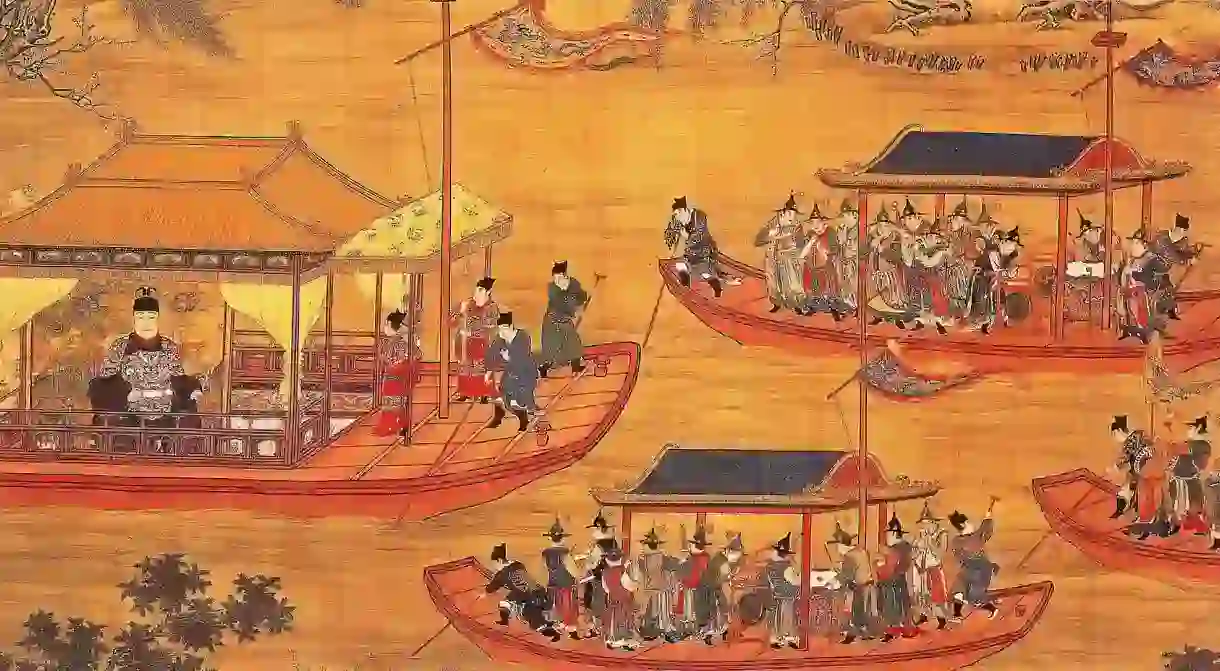A Brief History of China: Ming Dynasty

Re-establishing Chinese rule after the defeat of the Mongols, the Ming dynasty took an isolationist and authoritarian approach to leadership. Thanks to the dynasty’s fear of foreign invasion, the Great Wall was significantly lengthened and Beijing’s famous Forbidden City built under direction of the Ming. Yet, it was also during this time that China undertook its greatest naval voyage, spearheaded by the East’s answer to Magellan, and landed for the first time on the continent of Africa.
In Short
Dates: 1368–1644
Capital: Nanjing (1368–1644)
Beijing (1403–1644)
Notable People: Hongwu Emperor,Zheng He, Yongle Emperor

The Rise and Fall
Before the Ming, China was ruled by the Mongols, under the name Yuan. Although these foreign leaders claimed that Heaven had ordained them for rule in China, a series of natural disasters in the 1300s convinced the Chinese people otherwise, and a peasant rebellion was mounted against them. The Red Turban Army, as the peasants took to calling themselves, was led by a lowborn man named Zhu Yuanzhang. When the rebellion succeeded, Zhu Yuanzhang declared the beginning of the Ming dynasty and renamed himself the Hongwu Emperor, becoming the second commoner to rise to the highest position of power at the time in China.
Despite his humble beginnings, or perhaps because of them, the Hongwu Emperor deeply distrusted scholar-officials of the gentry class and established a secret eunuch police force to purge those whom he was at odds with. During his three decades-long reign, over 100,000 such officials were killed. He was also paranoid about further Mongol invasions and thus ordered the construction of garrisons along the Beijing lengths of the Great Wall. Some 130 garrisons went up before his death, after which his son, the Yongle Emperor, continued and expanded these defence strategies.
The Yongle Emperor also continued his father’s work with the secret police, granting the force unprecedented extralegal authority. One eunuch on the force, a favorite of the emperor named Zheng He, used this authority to launch a series of explorations through the South Pacific and Indian Oceans.
Zheng He’s voyages, although largely passed over by official Chinese histories, greatly contributed to China’s political clout abroad. One of He’s ships was reportedly a massive 400 feet long, well over four times the size of Christopher Columbus’ largest ship. In total, the Muslim eunuch undertook seven voyages, reaching places as far west as Mecca and Mombasa. As a measure of good will and to prove he was not attempting to conquer the lands he explored, He brought with him on each journey gold, silver, porcelain, and silk and, at times, returned with exotic new animals like ostriches, zebras, and camels. Sadly, He’s voyages had little lasting impact on Chinese trade, existing primarily to stroke the ego of the Yongle Emperor. After the Yongle Emperor’s death, the succeeding emperor ordered He to cease his voyages, and the Ming dynasty retreated to its shell once again.

The Ming dynasty continued to go strong in its isolationism, becoming one of the longest-lived Chinese dynasties. However, a combination of factionalism, eunuch interference, and a succession of weak emperors led to civil rebellion. In a moment of weakness, Ming leaders requested help fighting the rebels from Manchu tribes to China’s north. And in an ironic turn of events, the protectionist and xenophobic Ming was conquered by the Manchus, and the dynasty, which was preceded by a foreign dynasty, was succeeded by a foreign dynasty as well.
Legacy
The legacy of the Ming dynasty is everywhere. It is in the great architecture of Beijing and Nanjing and it is in the Chinese ceramics sitting in your cabinet gathering dust.
The vast majority of tourist sites in China today date back to the Ming, in part due to the Ming’s relative temporal closeness and in other part to the population boom and literati proliferation during the time.
The Great Wall? Of course that’s Ming (well, mostly.)
The Forbidden City? Ming.
Temple of Heaven? Ming.
Yu Gardens in Shanghai? Yes, that is Ming as well.














